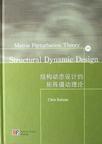结构动态设计的矩阵摄动理论
2007-1
科学
陈塑寰
248
A matrix perturbation theory in structural dynamic design is presented in this book The theory covers a broad spectrum of subjects,the perturbaion methods of the distinct eigenvalues and repeated/close eigenvalues,the perturbation methods of the complexmodes of systems with real unsymmetric matrices,the perturbation methods of the defective/near defective systems,random eigenproblem and the interval eigenproblem for the uncertain structures.The contents synthesized the most recent research results in the structural dynamics.Numerical examples are provided to illustrate the applicationsof the theory in this book. This book is recommended to graduates,engineers and scientist of mechanical,civil,aerospace,ocean and vehicle engineering.
PrefaceChapter 1 Finite Element Method for Vibration Analysis of Structures 1.1 Introduction 1.2 The Hamilton Variational Principle for Discrete Systems 1.3 Finite Element Method for Structural Vibration Analysis 1.4 The Mechanics CharaCteriStiC Matrices of Elements 1.4.1 Consistent Mass Matrix of a Rod Element 1.4.2 Consistent Mass Matrix of a Beam Element 1.4.3 Plate Element Vibrating in the Plane 1.4.4 Plate Element in Bending Vibration 1.4.5 Lumped Mass Modal 1.5 Vibration Eigenproblem of Structures 1.6 Orthogonality of Modal Vectors 1.7 The Rayleigh—Ritz Analysis 1.8 The Response t0 Harmonic Excitation 1.9 Response to Arbitrary Excitation 1.10 Direct Integration Methods for Vibration Equations 1.10.1 The Central Difference Method 1.10.2 The Wilson Method 1.1O.3 The Newmark Method 1.11 Direct Integration Approximation and Load Operators in Modal Coordinate System 1.11.1 The Central Difference Method 1.11.2 The Wilson-0 Method 1.11.3 The Newmark MethodChapter 2 Matrix Perturbation Theory for Distinct Eigenvalues 2.1 IntrOduCtiOn 2.2 Matrix Perturbation for Distinct Eigenvalues 2.2.1 The 1st Order PertUrbation 2.2.2 The 2nd 0rder Perturbation 2.2.3 Computing for the Expansion Coefficients Cli and C2i 2.2.4 Numerical Examples 2.3 The Improvement for Matrix Perturbation 2.3.1 The William B.Bickford Method 2.3.2 The Mixed Method of Matrix Perturbation and Rayleigh’S Quotient 2.3.3 Numerical Example 2.4 High Accurate Modal SuperpOSitiOn for Derivatives of Modal Vectors 2.4.1 The B.P.Vang Method 2.4.2 High Accurate Modal SuDerD0sition 2.4.3 Numerical Example 2.5 Mixed Basis Superp0Sition for Eigenvector Perturbation 2.5.1 Constructing for Mixed-Basis 2.5.2 The 1st Order Perturbation Using Mixed-Basis Expansion 2.5.3 The 2nd 0rder Perturbation Using Mixed-Basis Expansion 2.5.4 Numerical Example 2.6 Eigenvector Derivatives for Free-Free Structures 2.6.1 The Theory Analysis 2.6.2 Effect of Eigenvalue Shift灿on the Convergent Speed 2.6.3 Numerical Example 2.7 Extracting Modal Parameters of Free—Free Structures from Modes of Con strained Structures Using Matrix Perturbation. 2.8 Determination of Frequencies and Modes of Free—Free Structures Using Experimental Data for the Constrained Structures 2.8.1 GenerMized Stiffness,Mass,and the Response to Harmonic Excitation forFree—Free Structures 2.8.2 Przemieniecki’S Method(Method 1) 2.8.3 Chen—Liu Method(Method 2) 2.8.4 Zhang—Zerva Method(Method 3) 2.8.5 Further Improvement on Zhang—Zerva Method(Method 4) 2.8.6 NumericM Example 2.9 Response Analysis to Harmonic Excitation Using High Accurate Modal Superposition 2.9.1 High Accurate Modal Superposition(HAMS) 2.9.2 Numerical Examples 2.9.3 Extension of High Accurate Modal Superposition 2.10 Sensitivity Analysis of Response Using High Accurate Modal SuperpositionChapter 3 Matrix Perturbation Theory for Multiple Eigenvalues 3.1 Introduction 3.2 Matrix Perturbation for Multiple Eigenvalues 3.2.1 Basic Equations 3.2.2 Computing for the 1St Order Perturbation of Eigenvalues 3.2.3 Computing for the 1st Order Perturbation of Eigenvectors 3.3 Approximate Modal Superposition for the 1st Order Perturbation of Eigenvectors of Repeated Eigenvalues 3.4 High Accurate Modal Superposition for the 1st Order Perturbation of Eigenvectors of Repeated Eigenvalues 3.5 Exact Method for Computing Eigenvector Derivatives of repeated Eigenvalues 3.5.1 Theoretical Background 3.5.2 A New Method for Computing Vi 3.5.3 Numerical Example 3.6 Hu’S Method for Computing the 1st Order Perturbation of Eigenvectors 3.6.1 Hu’S Small Parameter Method 3.6.2 Improved Hu’S MethodChapter 4 Matrix Perturbation Theory for Close Eigenvalues 4.1 IntroduCtiOn 4.2 Behavior of Modes of Close Eigenvalues 4.3 Identification of Modes of Close Eigenvalues 4.4 Matrix Perturbation for Close Eigenvalues 4.4.1 Preliminary Considerations 4.4.2 Spectral Decomposition of Matrices K andM 4.4.3 Matrix Perturbation for Close Eigenvalues 4.5 Numerical Example 4.6 Derivatives of Modes for Close EigegvaluesChapter5 Matrix Perturbation Theory for Complex ModesChapter6 Matrix Perturbation Theory for Linear Vibration Defective SystemsChapter6 Matrix Perturbation Theory for Near Defective Sytems Chapter7 Random Eigenvalue Analysis of Structures with Random ParametersChapter8 Matrix Perturbation Theory for Interval Eigegproblem References
《结构动态设计的矩阵摄动理论》由科学出版社出版。

该书内容充实,观点明确新颖,是本不错的好书